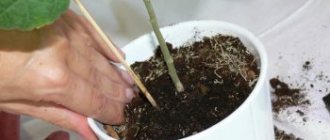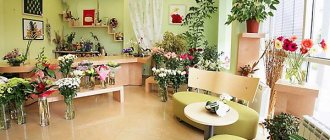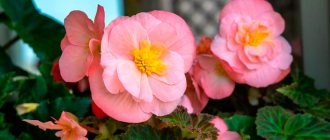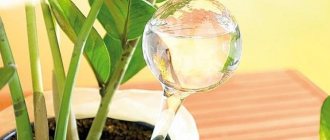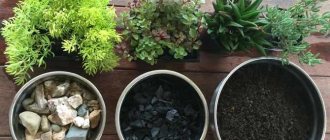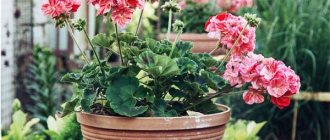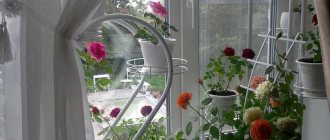Plants create a favorable microclimate, give a feeling of peace and tranquility, collect dust and humidify the air, flowers scent the room and lift your spirits. Caring for green pets develops in a child a sense of responsibility and a caring attitude, as well as an interest in observations and research. The list of plants suitable for a children's room is much longer than presented here. In this article I provide a description and photo of the most popular, beautiful and affordable ones.
Plants for a children's room: possible
Indoor plants that can be placed in a children's room:
- Plants that the child likes and are pleasing to his eyes.
- Plants with healing properties ( rose, rosemary, geranium ).
- Plants that are natural air filters ( chlorophytum, asparagus, begonia, etc.)
Below I will give descriptions of the most popular indoor plants for a children's room:
- Sansevieria
- Chlorophytum
- Kalanchoe
- Tradescantia
- Violet
- Fittonia
- Begonia
- Spathiphyllum
- Anthurium
- Maranta
- Dracaena
- Decembrist
- Cyperus
- Hibiscus
- Cyclamen
- Crassula
- Pelargonium
- Balsam
- Fern
- Gardenia
- Hippeastrum
- Orange/lemon tree
- Calla
- Cypress
- Peperomia
Plants for a children's room: not allowed
1. Plants with poisonous juice that irritates the skin and mucous membranes should not be placed in a nursery. These include:
- Dieffenbachia,
- Yucca,
- Monstera,
- Alocasia,
- Oleander,
- Ekhmeya,
- Spurge,
- Ficuses.
2. It is not recommended to place plants with thorns, thorns that can harm the physical body in nurseries with children under 14 years of age:
- cacti,
- aloe.
3. Emitting a strong aroma that makes your head hurt.
4. Causing allergic reactions.
5. Do not place plants with bright, appetizing but poisonous fruits, such as nightshade .
6. Plants that are difficult to care for and cannot be moved or rotated frequently.
7. Very fragile plants that break quickly.
Photo: plants with thorns, berries, a strong odor and poisonous juice are dangerous for children
Tips for parents
- “Introduce” your baby to the plant. Give it a name, tell it a little about the plant, explain that it is alive and needs to be handled with care. Tell us how to water and spray so that the child can do it himself.
- A calm atmosphere and pleasant music contribute to better and faster plant growth.
- Plant plants in bright and unusual pots. Your baby's urge to garden and explore the world around him will be stronger. He will be interested in caring for plants that grow in brightly colored pots, in the shape of animals or favorite cartoon characters.
- You can paint ordinary pots yourself. Draw your favorite animals or heroes on them.
- Old toys, for example, the body of a car, can also serve as pots.
- Children also really like compositions made from several types of plants. For example, a florarium with succulents, without thorns .
- If children are still small, do not place pots on the floor, as they may begin to take the soil out of the pot, scatter it on the floor or put it in their mouth.
- Place the plants where there is light and no drafts so that the beneficial essential oils they release do not erode, but reach your baby.
Photo: teach your child to care for plants
Growing and caring for Tradescantia Blossfeld
Tradescantia blossfeldiana has long, fleshy leaves that are red on the underside.
As you can see in the photo, the Variegata form of this type of Tradescantia has creamy green leaves that turn pink in the light:
- Family: Commelinaceae (Commelineaceae).
- Homeland: South America.
- Location: As bright as possible, but protected from direct sun.
- Temperature: Room; in winter and cooler, not lower than 10 ° C.
- Humidity: Tolerates dry air.
- Substrate: Flower soil mixture.
- Watering: Maintain moisture.
- Feeding: When caring for this home tradescantia, fertilizers need to be applied every 4 weeks; no feeding is required in winter.
- Replanting: It is better to grow new plants every year.
- Pruning: Trim the tops regularly to ensure thicker growth.
- Reproduction: Cuttings.
- Pests, diseases: Rare.
List of plants for a children's room
In modern city apartments, the presence of indoor plants in a room is not just a decorative technique, but also a necessity. They are especially needed in rooms where there are plastic windows, furniture made of chipboard and MDF, suspended ceilings, vinyl wallpaper, and plastic panels.
Sansevieria (mother-in-law's tongue)
There are many types of sansevieria (I wrote about it in detail in this article), this is an unpretentious herbaceous plant.
- It cleans the air very well and collects dust. Dust from the leaves can be removed with a damp cloth or given a warm shower.
- With proper care, it grows quite quickly and requires almost annual replanting into a new pot.
- It looks impressive in the interior. Suitable for almost any style.
- It does not like direct sunlight, but it will also feel uncomfortable in a dark corner.
Cyperus
Grows well in dark corners. Likes frequent watering and spraying. I gave my advice on caring for cyperus at home in this article.
- An adult plant, planted in a large pot, grows up to 1 m in height.
- It grows as a lush bush resembling a palm tree.
- Relevant in a room where the wallpaper depicts tropical plants.
- Humidifies the air and has a calming effect on the nervous system.
Photo: sansevieria and cyperus in the children's room
Kalanchoe
Compact, abundantly flowering plant. Small flowers come in a variety of colors - yellow, pink, red, crimson and others. It blooms 2 times a year, the aroma is not noticeable.
- It is very easily propagated by cuttings and grows.
- Loves sunny places.
- If you don't do the pruning, it stretches upward, the lower branches are exposed, and it looks sloppy.
Well moisturizes and purifies the air.
Photo: Kalanchoe
Tradescantia
Looks good in a hanging pot that can be placed on a wall or near a window.
- An unpretentious plant with small white flowers, without a distinct odor.
- Humidifies the air and harmonizes the space.
Violet (Saintpaulia)
This small, compact plant, with velvety leaves and bright flowers, will decorate a nursery and create a cozy atmosphere.
- It collects dust, as all the leaves are covered with tiny hairs. Violet leaves should be washed very carefully under a warm shower.
- The aroma of flowers is practically inaudible.
- Loves slight shading; eastern and northern windows are ideal.
Pelargonium
A fragrant plant that may cause an allergic reaction in some. Pelargonium repels some insects with its scent. It has medicinal properties; its leaves and juice can soothe a toothache or cure otitis media. Helps well with diseases of the nervous system. Purifies the air and destroys pathogens in the air.
- Flowering is lush, occurs from spring to autumn.
- A huge number of varieties with a wide variety of flower shapes (double, simple), various colors and shades, from dark burgundy, soft pink, crimson to white.
- Prefers sunny, bright places, but can grow in shade, but will stretch.
Photo: pelargonium and violet blooming
Fittonia
Valued for the beautiful color of the leaves, which come in different shades of green, reddish, pink, and beige. Fittonia with pink leaves will organically fit into the nursery of a “little princess”. It grows slowly as a lush, low bush.
- Requires constant air temperature, watering should be moderate.
- Does not like direct sunlight and drafts.
- It will feel good on east and west windows.
Chlorophytum
A very useful plant in the house. Like a sponge, it absorbs carbon dioxide and all harmful impurities in the surrounding air.
- Harmonizes space and easily fits into any interior.
- Cats and small children love to chew on it - it is completely harmless.
- Does not like direct sunlight.
Begonia
Decorative - deciduous plant, valued for the beauty of its leaves more than for its flowering. Many new varieties of begonias have appeared. There are red leaves, soft green ones, speckled and dotted.
- An unpretentious plant, it purifies the air well, releasing essential oils into it.
- Harmonizes space and decorates the interior in any style.
- Does not like direct sunlight, appreciates space and well-lit places.
Photo: chlorophytum and begonia
Spathiphyllum and Anthurium
Beautiful flowering, odorless. It grows as a compact bush and can decorate any interior style.
- Will be grateful for frequent spraying and timely watering.
- Does not like frequent moving from place to place.
- Creates an atmosphere of peace and tranquility.
- Loves shaded places, without direct sunlight.
| Spathiphyllum and anthurium purify and humidify the air |
Anthurium is prized for its beautiful leaf shape and flowers.
- Flowering is frequent.
- Tolerates shade well, does not like direct sunlight.
- It will grow well on eastern windows and inside the room near the window.
Photo: spathiphyllum flowers
Maranta
A low-growing plant valued for the unusual properties of its leaves. At night they curl into a tube and open at dawn. The flowers are small and unattractive.
- Does not like direct sunlight on the leaves, which can cause sunburn.
- It will grow well in a shaded place.
- Loves frequent watering and moist, warm air.
It will decorate both the window sill and the student’s desk.
Dracaena
A plant resembling a palm tree.
- Loves bright lighting, without direct sunlight.
- It will feel good on the floor near the window or on the windowsill near the balcony.
- In hot weather, daily spraying with water at room temperature is advisable.
Photo: dracaena and spathiphyllum
Decembrist (zygocactus)
A common plant. Grown for its abundant, beautiful blooms that begin in December, hence the name
- The color of the flowers can be different (white, red, pink, crimson). The flowers smell weak.
- Purifies the air and ionizes it.
- Does not like long exposure to direct sunlight.
Hibiscus (Chinese rose)
Many new varieties have been developed, and when you see them bloom, you immediately want to have such a plant in your home. With proper care, the plant can grow above 2 m. If the room is small, then it is better to plant a small plant and do timely pruning, preventing the plant from growing. And if the room is large, you can plant a small bush and grow a large tree, which will become an accent during flowering.
- The flowers are large, there are double and simple, the aroma is not pronounced.
- Loves well-lit rooms, warm showers and timely watering.
Creates coziness in the room and cleans the air well. Children's fatigue decreases and a creative mood appears.
Cyclamen
A compact plant that requires certain conditions. This plant is for older children over 10 years old. Its leaf shape and lush flowering promotes the development of creative abilities. The energy of cyclamen causes children to stop being capricious and calm down.
- Does not like deepening when planting and overflows.
- Does not like direct sunlight.
- Looks beautiful on a desktop or on a windowsill.
Crassula (money tree)
An unpretentious succulent that will forgive small mistakes in care.
- Watering is moderate, loves spraying and warm showers.
- The leaves attract dust well.
- Doesn't like dark corners.
Photo: Crassula (money tree)
Balsam
Fast growing, unpretentious plant. It cleanses the air well and soothes.
- It grows as a lush bush.
- The color of the flowers can vary, as well as the size of the flower.
- Loves bright, sunny places.
Hippeastrum
Releases antibacterial substances into the air that absorb bacteria and improve your mood. A flowering plant decorates a room and gives a feeling of peace and tranquility. A plant that requires care.
Recommended for children over 10 years old.
Ferns (Asparagus, Nephrolepsis)
They create a forest, relaxing atmosphere in the room, thanks to which schoolchildren and preschool children relieve stress and restore strength faster.
- Attracts dust particles well and purifies the air.
- They are unpretentious in care, tolerate shading well, grow quite quickly, forming lush bushes.
Gardenia
A very fragrant plant, so it is not recommended to place it in small rooms with poor ventilation. The smell is very pleasant, but when there are a lot of flowers, the smell can be very strong, which can give you a headache. The flowers can be dried and then used in sachets.
- Loves moist air and frequent spraying.
- It is not recommended to place in direct sunlight.
- East or west windows are ideal.
Photo: gardenia
Orange or lemon tree
The leaves contain essential oils that saturate the air, disinfect it and have a calming effect on the human nervous system. During flowering, the room is filled with the most delicate aroma, which lifts your spirits and fills you with strength.
The fruits are not only useful, but the process of growing them develops in the child a sense of delight, responsibility and love for nature. In the room where such plants grow, the child will undergo aromatherapy every day.
Photo: lemon tree leaves smell delicious and aromatic if you rub them a little
Calla
The energy of calla lilies calms and regenerates the human body. Sharpenes the senses. A flowering plant that can decorate any interior.
- Does not like direct sunlight.
- It is unpretentious in care, but does not like the soil to dry out.
Cypress
Has antibacterial properties. Releases phytoncides into the air, which have a beneficial effect on the human body. Relieves stress and reduces fatigue.
- Attracts dust particles, moisturizes and purifies the air.
- When planted in a large pot it can grow quite large.
You can dress it up for the New Year and it will replace a live Christmas tree.
All about violets
Natural habitat
The ancestors of modern indoor pets grow in Africa. The massifs of the Ulugur and Usambara (Usambara) mountains are the natural habitat of Saintpaulia , most varieties are located on the slopes of the latter and therefore received a second name, Usambara (Usambara) violet.
Violets in natural conditions.
In East Africa, violets grow in humid climates, often near waterfalls and on river terraces. In such conditions there is a lot of water dust and fog, and the soil is light and well permeable to moisture and air.
Origin story
The description of indoor plants should begin with the history of their occurrence in nature.
Walter von Saint-Paul , Commandant of the Uzambara District of German East Africa – German Colony. In 1892, while studying the flora and fauna of the territories subordinate to him, he discovered flowers in the mountains and collected seeds to understand what kind of plant it was.
They were then sent to his father, who was the president of the German Dendrological Society, Ulrich von Saint-Paul, and this is how they ended up with Hermann Wendland.
The scientist named the cultivated plant grown in 1893 Saintpaulia , and the name was given to the addition violet flower for the shape of the flower. This species was separated into a separate genus, named after the father and son who discovered it.
Next, the flower was presented at an exhibition in Goethe, where the rights to breed on a production scale were purchased by the Benari company.
Violets were brought to the USA in 1927 , and there they were recognized as ideal indoor plants. From that moment on, the mass production of new varieties began and by 1949 there were already 100 of them, and today their number is more than 32 thousand.
Important! More than 2000 varieties have been bred by domestic breeders.
Biological classification
So, what is a violet from a biological point of view - is it an herbaceous plant or not? Saintpaulias are classified as a separate genus - they are evergreen herbaceous plants of the Gesneriaceae family.
The structure of an indoor violet is as follows:
- the stem is shortened, which leads to the formation of a rosette of leaves;
- the leaves are respectively arranged in rows and very close to each other;
- the leaves on the stem are round in shape, fleshy and leathery, covered with villi;
- the base of the leaves is usually slightly heart-shaped, and the apex is rounded or slightly pointed;
- The color of the leaves varies from dark to light green; they are also variegated and spotted, sometimes almost white.
Next, is the violet a monocot or a dicotyledon? The houseplant violet is bipolar . Flowers collected in racemes usually have five petals, several stamens and one pistil. The calyx consists of five sepals located on the receptacle. The violet flower pattern is shown in the picture below.
The structure of a violet flower.
After pollination, a seed capsule is formed. The seeds themselves are very small and have average germination capacity, which is lost over time.
Based on this information, you can create a passport for a houseplant:
- plant biology passport: Kingdom: plants;
- Department: flowering;
- Class: double-field;
- Order: clear-flowered;
- Family: Gesneriaceae;
- Genus: Saintpaulia;
- Application: indoor plants;
- Natural area: mountainous areas of eastern Africa.
- simplified violet plant passport for kindergarten: Kingdom: plants;
- Department: flowering;
- Genus: Saintpaulia;
- Use: indoor plants.

